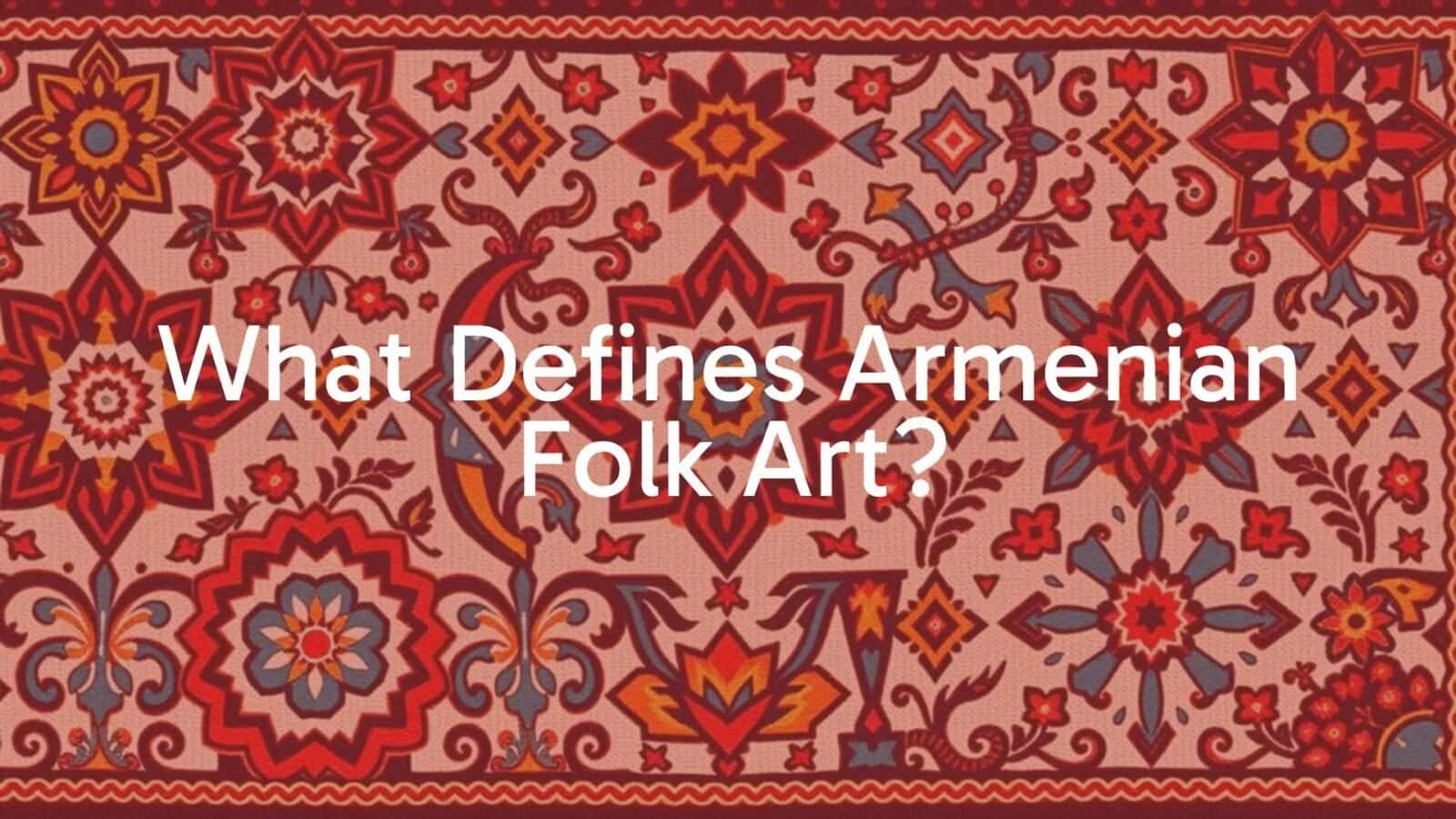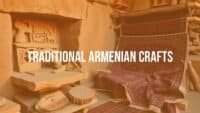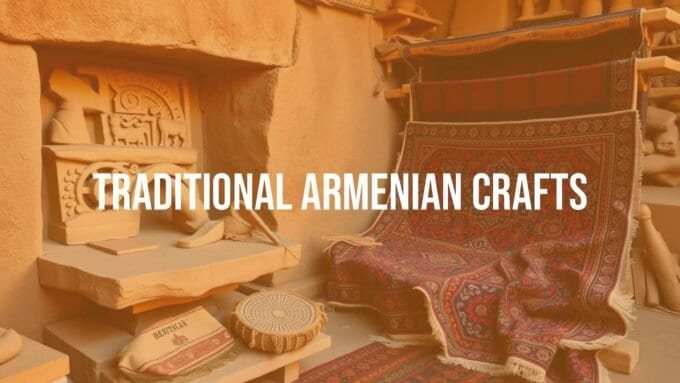Armenian folk art grew from thousands of years of history, faith, and daily life on the Armenian Highland. It is a shared kind of art, rooted in the lives of the Armenian people, and it keeps changing with time. Instead of focusing on one artist’s genius, folk art comes from community life and shows common values, beliefs, and customs. It is made by people for people, often useful in the home or in public life, while also being beautiful. This close link to community and heritage gives Armenian folk art its lasting appeal and clear identity.
At its core, Armenian folk art tells a story of survival, strength, and a steady cultural identity. From carved stones to woven carpets, every piece carries voices from the past. It goes beyond decoration and acts like a living record of a people’s memory and spirit.
Traditional Themes and Motifs in Armenian Folk Art
Armenian folk art is full of themes and symbols that carry deep meaning. Common images include geometric designs, stylized plants and animals, and signs from pre-Christian beliefs and Christian art. The nazar (evil eye) appears in clothing, jewelry, and home decor as a protective sign. Ideas like the garden-world, the holy mountain, and the temple show a close tie to nature and sacred places.
- Geometric patterns (knots, stars, spirals)
- Nature motifs (pomegranates, vines, flowers)
- Animal figures (lions, birds, rams, mythical creatures)
- Christian symbols (crosses, saints, doves)
- Protective signs (nazar/evil eye)

After Armenia adopted Christianity early on, Christian signs became central. The cross, shaped into the Armenian khachkar, stands out most. Animals, real and imagined, often point to strength, wisdom, or care. Scenes from daily life-farming, feasts, and rituals-also appear, keeping the art close to human experience.
Materials and Techniques Popular in Armenian Folk Traditions
Materials and methods in Armenian folk art show the skill and creativity of its makers. Stone is key in a land often called “a country of rocks.” It was shaped into buildings, khachkars, and small sculptures. Wood carving is also common, used in homes and on buildings, turning natural material into useful and lovely objects.
- Stone: architecture, khachkars, reliefs
- Wood: doors, beams, furniture, small tools
- Textiles: carpets, embroidery, clothing
- Metal: engraving, jewelry, vessels, weapons
- Ceramics and wall arts: pottery, mosaics, frescoes
Textiles-carpets, embroidery, and dress-are a major part of Armenian folk art and trade. Wool and silk carpets are known for rich colors and detailed designs. Metalwork, including jewelry and engraved vessels, has a long history, from coins to gold and silver cups and fine ornaments. Ceramics, mosaics, and frescoes, with roots in Urartu, add to this rich mix, decorating both churches and homes.
How Ancient Origins Shape Armenian Folk Art History
Armenian folk art reaches back to very early times. These deep roots are not side notes; they are the base for later art. The land itself-its mountains and valleys-guided both material choices and symbols. This bond with place and early peoples still echoes today and keeps Armenian art connected across ages.
Knowing these early layers helps us see how simple signs carry many meanings built up over thousands of years. Old ways survived wars and cultural change, showing their strength and lasting value for Armenians.
| Period | Approx. Time | Main Features |
|---|---|---|
| Prehistoric | Before writing | Petroglyphs, shamanic signs, proto-script |
| Urartu and neighbors | Iron Age | Fortresses, metal art, royal images |
| Christian Armenia | 4th-7th c. and after | Churches, khachkars, stone carving |
| Medieval and Diaspora | 9th-14th c. and later | Bagratid/Cilician centers, mixed influences |
| Soviet to Present | 20th-21st c. | State art, revival, global links |
Petroglyphs and Early Rock Art of Armenia
Before written records, people in the Armenian Highland carved images into rock. These striking petroglyphs show animals, hunts, skies, and mysterious figures. They likely served as records, ritual signs, and early storytelling. They show a human need to speak to others and to leave a mark on the land-a need that still drives Armenian art.
Spirals, sun disks, and animal images seen in rock art appear later in refined forms. This steady thread ties early carvings to later folk art and shows an ongoing talk between people and nature.
Symbolism of Shamanic Symbols and Proto-Script
Early Armenian art carries many shamanic signs and proto-script that come before organized religion. These were more than decoration. People believed they could affect nature, bring fertility, and offer protection. Their patterns often mirror natural forces, the sky, or spirit beings.
We may not know every meaning today, but the repeat of certain shapes across time points to a shared memory. These early sign systems were steps toward writing and helped build a symbolic language that shaped Armenian folk art for centuries. Art in Armenia has long been tied to seeking meaning and the sacred.
Megalithic Structures and Ritual Objects Influencing Folk Traditions
Ancient stone circles, observatories, and tombs stand across Armenia as signs of early skill and belief. These big works, along with ritual objects found by archaeologists, left a strong mark on folk traditions. Their size and long life inspired awe and a sense of lasting presence, qualities later Armenian art would aim to show.
Ritual items made of stone, metal, or clay reveal careful design and belief. From animal figures to ceremonial bowls, they join function with symbol. The layout of ancient sites and their geometric order shaped later temple plans, textile grids, and carved details.
Influence of Urartu and Ancient Civilizations on Armenian Aesthetics
The Armenian Highland stood at a meeting point of strong ancient cultures. Urartu, an Iron Age kingdom, left a deep mark through its skills and symbols. The Hittites and Assyrians also added ideas through trade and conflict. Over time, local artists mixed these inputs into a style that feels clearly Armenian.
We see the strength of Armenian making and older patterns that keep appearing. The back-and-forth with neighbors led to local art that could absorb new ideas and reshape them into its own voice.
Royal Iconography and Fortress Art Forms
Urartu built mighty fortresses and used royal images to show power. Early metal sculptures often showed animals linked to strength, fertility, or protection. These bold forms and fine metalwork foreshadow later Armenian skill in metal and stone.
Art on fortress walls-reliefs, murals, and carved details-was meant to impress and even scare, showing military force and kingship. Parts of this grandeur filtered into later Armenian monumental and church art.
Craft Traditions from Hittite and Assyrian Connections
Armenian crafts also grew through contact with Hittite and Assyrian cultures. Trade and wars moved ideas, styles, and tools across borders, creating a rich mix.
Hittite stone carving and myth themes may have influenced local art. Assyrian reliefs, big buildings, and metalwork likely shaped Armenian engraving and use of precious metals. Armenian makers took in what fit and kept a clear identity, showing steady change and invention.
Impact of Christianity on Armenian Folk Art
When Armenia adopted Christianity in the early 4th century, art changed direction. Old beliefs did not vanish. Instead, many symbols were re-read within a Christian story. The result was an Eastern Christian art that felt very local in style and feeling.
Church building and decoration brought new needs for images and design. This mix of sacred story and local craft gave Armenian folk art a special voice, joining shared Christian themes with Armenian signs and forms.
Development of Church Architecture and Ornamented Stonework
After conversion, Armenia began wide church building, creating an original style. Early churches sometimes rose on former pagan sites and kept some pre-Christian forms. From the 4th to the 7th centuries, simple basilicas grew into central plans, and by the 5th century the cone-topped dome was common.
A stand-out feature was the early use of figurative reliefs on church exteriors-rare in Byzantium. Stone became a surface for sacred stories. Rich stone ornament, from geometric bands to story scenes, came to define Armenian churches, joining sound structure with deep art.
Khachkars: Cross-Stones as Expressions of Faith
The most famous Armenian art form is the khachkar-cross-stone. These upright stones are unique to Armenia and show both faith and national identity. The word joins “khach” (cross) and “kar” (stone). Khachkars are more than crosses. They are detailed carvings made to mark events, honor the dead, or celebrate a person’s baptism. They link people to land and history.

The beauty of khachkars lies in their detail and symbol-rich design. Each stone shows the carver’s skill, turning hard rock into fine lace-like carving. Found near graves, monasteries, and roads, they stand like quiet witnesses to Armenian life and belief.
Evolution and Regional Distinctions in Khachkar Designs
Khachkar design changed over time, rising to new heights in the 9th-11th centuries under the Bagratids. Early stones were simpler and showed the cross plainly. Later examples became very rich, with interlace, rosettes, and plant forms framing the cross. The cross often grows like a tree or holds carvings inside its arms, pointing to the tree of life or the resurrection.
Regions developed their own looks. Some areas used abstract and geometric forms; others leaned more natural. Stone type, carving tools, and local taste shaped these differences. Each khachkar feels singular yet fits within a shared symbolic system.
Symbolic Geometry and Theology in Stone Sculpture
Khachkars hold careful geometry and religious meaning. Their layouts reflect views of the cosmos and church teaching. The cross usually stands on a circle or star, pointing to eternal life and the victory of Christianity. Endless knots can speak of God’s unending nature and the link between human and divine.
Pomegranates, grapes, and other fruit suggest abundance, life, and the blood of Christ. Birds-often doves-appear near the top as signs of the Holy Spirit or souls rising. Every part, from tiny rosettes to the full plan, carries messages of faith, hope, and memory. These stones show a union of craft skill, symbol, and belief.
Armenian Manuscript Art: Miniatures and Calligraphy
Armenian manuscript art, with its small paintings and fine script, reached a high point between the 5th and 17th centuries. These books were hand-made and carefully decorated to carry spiritual ideas, history, and literature. Before printing was common, each book was unique, made by scribes, painters, and binders working together. The images and letters lifted the text and made reading a visual joy.
Many manuscripts were lost, but those that remain show great skill and deep feeling. They blend local forms with outside ideas, all seen through a Christian eye.

Prominent Scriptoria Such as Gladzor and Tatev
Manuscripts were produced in scriptoria, mostly inside monasteries that also served as schools and art studios. Gladzor and Tatev are famous examples from the medieval era. These places brought together scholars, scribes, and painters who copied and decorated texts with bright colors and complex designs.
Gladzor University (13th-14th centuries) produced books known for expressive figures, bold color, and inventive layouts. Tatev Monastery also made many beautiful volumes. These centers acted as guardians of learning and art during hard times.
Visual Storytelling Through Miniatures and Marginalia
Miniatures did more than illustrate. They told Bible stories, lives of saints, and history in pictures. These images filled pages or sat within the text, using vivid color, clear composition, and clear signs to carry complex ideas and feeling.
Margins often held smaller images and decorations-marginalia-that added humor, symbols, and small scenes. This mix of main images and playful edges created a lively page. The 13th century is often seen as the peak, tied to Toros Roslin, the best-known medieval Armenian illuminator.
Techniques in Color, Pigment, and Calligraphic Tradition
Making an illuminated manuscript took careful work with materials. Painters ground minerals, plants, and insects to make pigments, then mixed them with binders like egg yolk to get bright, lasting color. Reds, blues, greens, and gold shine in Armenian pages.
Calligraphy mattered as much as painting. Scribes trained in different Armenian scripts, from formal uncials to faster hands. The shape of letters and decorated initials added to the beauty. Together, script and image turned books into masterpieces and showed deep respect for the written word.
Medieval and Diaspora Influences in Armenian Folk Art
The medieval period brought both growth and turmoil that shaped Armenian folk art. Constant contact with other empires brought new ideas and styles. At the same time, many Armenians formed communities abroad, especially in Cilicia, which became a center of culture. Art kept growing both at home and away, carrying forward shared forms and symbols.
Ties with Byzantine and Persian culture left strong marks. Local forms blended with outside elements and still kept an Armenian core. This mix shows both resilience and flexibility in Armenian folk art.
Artistic Centers in Bagratid and Cilician Armenia
Under the Bagratids (9th-11th centuries), Armenia saw a burst of building and carving. Cities and churches rose in Ani and around Lake Van, including the Cathedral of Ani and the church on Akdamar Island. This era also saw a flowering of carved khachkars.
Cilician Armenia on the Mediterranean grew into a major art center. Its location encouraged close contact with Byzantium, Crusader states, and Islamic cultures. Cilician manuscript painting developed a fresh school with strong colors and lively scenes. Artists blended many inputs into a polished style that matched the kingdom’s setting and added greatly to Armenian art.
Byzantine and Persian Influences on Folk Expressions
Living near powerful neighbors, Armenian artists absorbed parts of Byzantine and Persian art. From Byzantium came church images, building forms, and ornament that suited Armenian churches and books. The sense of sacred space and rich color fit well with local taste.
Persian influence shaped secular arts. Detailed floral designs, animal themes, and refined textiles became part of Armenian carpets, metalwork, and ceramics. Persian miniature painting also touched Armenian book art. Armenian makers combined these sources with their own motifs to create a blend that felt fully theirs.
Diaspora Folk Art: Echoes from Isfahan to Venice
Armenians who moved abroad helped keep folk art alive. In new places they kept their customs while adapting to local life. In New Julfa (Isfahan), silk weaving and metalwork grew in a style that mixed Persian taste with Armenian signs. On San Lazzaro in Venice, Armenian monks and printers made manuscripts and books that spread Armenian culture across Europe.
These communities guarded tradition and also tried new ideas, creating a living art that spoke of home and new worlds at once.
Role of Merchants and Migrant Artisans
Armenian merchants and traveling artisans spread art and craft across great distances. Trade routes carried goods and also styles, tools, and methods. Merchants moving between East and West brought back new ideas and materials.
Artisans who moved for safety or work set up shops in new towns and shared their skills. Cities like Tiflis (Tbilisi), Akhaltsikhe, Alexandropol, Karin, and Van became known for Armenian armorers, jewelers, and carpet makers. Their mobility kept traditions alive and open to change.
Distinctive Forms and Types of Armenian Folk Art
Armenian folk art covers many kinds of making and performing. Each shows clever design, taste, and strong ties to heritage. From textiles and wood to music and dance, these forms often share motifs and meanings built over ages.
Looking at these forms shows how common objects can carry beauty and story, and how group customs can become art that binds people together.
Textiles: Carpets, Embroideries, and Traditional Clothing
Textiles are central in Armenian folk art and in economic life. Armenian carpets are famous for rich color, dense pattern, and fine craft. Made of wool, silk, or both, each carpet speaks with traditional signs that carry meaning. They covered floors, decorated walls and niches, and wrapped furniture, turning rooms into symbolic spaces. Areas like Tavush, Syunik-Artsakh, Kharberd, and Van made well-known styles.

Embroidery decorates clothing, linens, and ceremonial items with delicate stitches and patterns-often flowers, geometry, and figures-with regional looks and personal touches. Traditional clothing itself shows art in cut, fabric, and trim, marking status, place, and celebration. The Armenian Museum of America holds a large collection that shows this long story.
Metalwork, Engraving, and Jewelry Craft
Armenia has deep roots in metalwork and jewelry. Urartu already made animal sculptures in metal, setting a path for later craft. Finds include household tools, weapons, and statues in bronze and tinned copper, showing both use and art.
Gold and silver became cups, medallions, and jewelry. Regional styles shaped how jewelers set stones and built patterns. A filigree bracelet from Van with star rosettes or a buckle with coral, turquoise, and enamel shows the range. Armenian armorers were famed for daggers, sabers, and shashkas, using methods that shifted with the times.
Ceramics and Domestic Ornamentation
Ceramics, mosaics, and frescoes reach back to Urartian days. Many pieces survive through digs, and reconstructions help us picture their full look.
Pottery for daily use was rarely plain. Makers added painted lines, glazes, and symbols-from simple geometry to plants and animals-bringing art into daily life. Even basic pots and bowls became carriers of culture, showing how art lived in the home.
Wood Carving and Rural Architecture
Wood carving turns timber into useful and beautiful pieces and closely links to rural building. In a land of stone, wood brought warmth and fine detail. Church doors, home trim, and furniture show careful hands at work.
In Eastern Armenia, stone houses, sometimes half-sunk into the ground, stood beside adobe homes in Western Armenia. Inside, carved beams, ceilings, and furniture added pattern and symbol. Smaller items-spoons, chests, instruments-also carry carved designs, placing art in everyday tasks.
Folk Music, Instruments, and Dance Traditions
Music and dance carry the voice of Armenian folk life. Early on, church music and folk songs used a native system (tetrachords), different from European tuning. Songs tell of love, grief, bravery, and work, passed down by ear. Key instruments include:
- Duduk (double-reed woodwind)
- Zurna (loud double-reed)
- Kanun (plucked zither)
- Dhol (drum)
Dance in Armenia is among the oldest in the region, shown even in rock art. Dances are group acts of joy, sorrow, and identity at weddings, feasts, and festivals. Movements often mirror farming, history, and social bonds. Together, music and dance keep a living tie to the past.
How Armenian Folk Art Endured Through Ottoman and Persian Rule
Under Ottoman and Persian rule, Armenian culture faced strong pressure. Even so, folk art lived on, adapted, and sometimes even grew. This shows deep pride and the value placed on art as a way to keep identity.
People often balanced open display with quiet resistance. Makers hid meaning in designs, picked up new tools or signs, and still kept an Armenian feel. Folk art proved able to bend without breaking.
Preservation and Innovation Amid Oppression
Across centuries of foreign control, Armenians worked to keep their art. Families and guilds passed knowledge by hand and word. When needed, crafts moved out of sight but stayed active.
Change often came from need. New materials or methods entered from the rulers, but Armenian motifs and meanings remained. Persian weaving methods might shape the carpet, but the symbols kept a local voice. Quiet choices and careful design kept culture alive, even when hidden.
Blending of Local and Foreign Motifs
Armenian artists did not simply copy outside styles. They mixed in select parts and reshaped them. The result was fresh art that still felt Armenian.
Persian floral swirls or calligraphic curves might meet the pomegranate, cross, or native geometry in one piece. This added layers of meaning and beauty and showed a smart way to survive: take what helps, keep what matters.
Impact of the Armenian Genocide on Folk Art and Memory
The Armenian Genocide of 1915 brought a huge loss of life and culture. Many artworks, skills, and places vanished. Traditions broke in many towns and villages. Even so, folk art became a way to remember, to speak of loss, and to hold on to identity.
Survivors and diaspora groups tried hard to save what they could and rebuild with art. Folk works carried memory and hope in a time of grief.
Cultural Losses and Survivor Testimonies in Art
The Genocide destroyed countless pieces and silenced many craftspeople. Entire centers of making, from khachkar fields to fine buildings, were ruined. The goal was often to erase Armenian presence.
Afterwards, art turned into witness. Survivors made objects that held their stories. At the Armenian Museum of America, dioramas made by survivors rebuild homes and villages from memory-like the Bogigian home or the Chorebanian House. These are more than models. They are acts of memory, holding a lost world in view.
Diaspora Artists and the Preservation of Folk Heritage
After the Genocide, diaspora artists became key guardians of folk heritage. Many were survivors who carried their skills abroad. They kept old forms, taught the young, and adjusted crafts to new places.
They built cultural centers, planted gardens with familiar plants, and made home museums. The dioramas at the Armenian Museum of America are one example. Through steady work, diaspora artists kept Armenian folk art alive and growing around the world.
Folk Art in Soviet and Post-Soviet Armenia
Under Soviet rule, Armenian folk art faced mixed conditions. The state promoted “national art,” which sometimes turned traditions into set patterns, yet it also gave artists platforms to work, though within ideology. Folk motifs appeared in art serving socialist goals, showing both pressure and persistence. After the Soviet collapse, a fresh wave of interest brought back many forms and connected them with the global Armenian community.
This story shows how folk art can bend with politics and still keep its core. Traditional forms can both reflect and resist power and later find new room to grow.
Folk Motifs Within Socialist Realist Art
During Socialist Realism, art was expected to fit state aims. Armenian artists had to handle these demands while keeping their roots. Folk patterns and colors often showed up in scenes of factories, farms, and Soviet pride.
Meanings could be watered down or changed, but familiar elements stayed visible. Artists found quiet ways to keep identity within official art. Folk forms survived inside a new frame.
Artistic Revival and Contemporary Folk Inspirations
After 1991, artists in Armenia gained more freedom. Many looked back to traditional forms to build new works. Old practices that had faded came back into use. Artists combined historic motifs with present-day ideas to make fresh art.
Today’s makers use old signs and methods in painting, sculpture, design, and digital work. This is not only a return but an active rethinking that links past and present.
Role of the Diaspora in Modern Folk Art Trends
The diaspora has been a strong partner in recent trends. During Soviet times, communities abroad often held onto traditions that faced limits at home. After independence, ties grew stronger, with support for projects, shows, and exchanges.
Diaspora artists work across cultures and bring Armenian motifs to new audiences. They also bring outside ideas back into Armenian art. Exhibits, funding, and teaching programs help keep folk art lively and forward-looking.
Legacy and Global Influence of Armenian Folk Art Today
Armenian folk art is alive today in Armenia and around the world. It keeps shaping new works and adds a clear voice to global culture. From ancient rock carvings to present-day design, it forms a long chain of making and meaning.
As people connect across borders, Armenian folk art reaches new viewers and new media. Its strength lies in its human stories, rich symbols, and careful craft passed down through many generations.
Contemporary Artists Reviving Folk Traditions
A new wave of Armenian artists is working with folk themes and giving them fresh form. They use khachkar motifs, manuscript pages, textile patterns, and ancient signs in painting, sculpture, performance, and digital art. They respect the past and also test new paths.
By mixing tradition with new tools and materials, they keep the art active and relevant. This keeps the line between old and new open and alive.
International Exhibitions and Recognition
Armenian folk art appears more often in major shows worldwide. Museums in France, the United States (such as the Metropolitan Museum of Art and the Armenian Museum of America), and many other places display textiles, jewelry, dress, and more. These exhibits help people understand the history and beauty of Armenian making.
Armenian success on global stages-like the Leone d’Oro for Best Pavilion at the Venice Biennale in 2015-shows the broad impact of Armenian art, including folk roots. This wider attention raises the place of Armenian folk art in world culture.
Digital Preservation and Education Initiatives
The digital era offers new ways to keep and share Armenian folk art. Institutions and individuals use technology to record, archive, and share images and data. Online collections and virtual tours let people study khachkars, manuscripts, and carpets from anywhere.
Educational programs-on the web and in person-help young people and non-Armenian speakers learn symbols, try traditional crafts, and see the history behind each form. Digital tools help keep this legacy safe and open doors for new learning and creativity.















Leave a comment